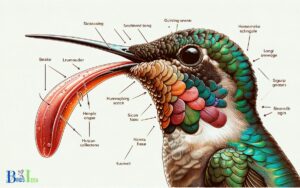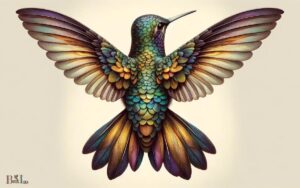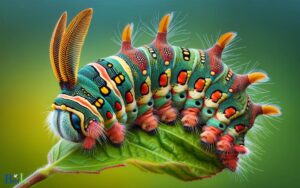What Does a Hummingbird Feather Look Like? Small!
A hummingbird feather is small and delicate, with vibrant colors ranging from green and blue to red and orange, depending on the species.
The feathers are iridescent, meaning they can change color when viewed from different angles due to the light refracting properties of their structure.
Key Takeaway
Types Of Hummingbird Feathers
When it comes to hummingbirds, their feathers are not only essential for flight but also contribute to their vibrant and enchanting appearance.
These tiny birds possess an impressive array of feathers that are designed to perform specific functions.
Contour Feathers
One of the most visible feathers on a hummingbird is its contour feathers.
- These are the feathers that cover the bird’s body and give it its characteristic shape and coloration.
- Contour feathers are sleek and slender, with specialized hooks and barbs that interlock, creating a tight and smooth surface.
- The arrangement of these feathers not only aids in flight by reducing air resistance but also plays a vital role in protecting the underlying down feathers.
- These feathers exhibit a stunning diversity of colors and patterns, varying from species to species.
The iridescent hues found on these feathers result from light interference caused by the microscopic structure of the feathers themselves.
As the hummingbird moves, the colors on its contour feathers can shimmer and change, creating a mesmerizing display.
Down Feathers
In addition to contour feathers, hummingbirds possess a layer of down feathers underneath their contour feathers.
- These down feathers are soft and fluffy, providing excellent insulation against the cold and heat.
- They are especially crucial for keeping the tiny hummingbird warm during cooler nights and high-altitude flights.
- The down feathers are also responsible for maintaining the bird’s body temperature by trapping a layer of air close to the skin, acting as a natural insulator.
- This not only helps to keep the hummingbird warm but also conserves energy that would otherwise be expended on regulating body temperature.
Down feathers contribute to the overall buoyancy of the bird, allowing it to hover effortlessly while feeding on nectar.
Filoplumes
While contour feathers and down feathers are the most well-known types, hummingbirds also possess a lesser-known type called filoplumes.
- Filoplumes are delicate, hair-like feathers that are sparsely distributed among the contour feathers.
- They lack barbs and hooks and serve a more sensory role rather than providing insulation or flight assistance.
- These specialized feathers have a small tuft of barbs at the tip, often protruding above the contour feathers.
- Filoplumes are thought to play a role in providing sensory feedback to the bird, assisting in balance and maneuverability during flight.
- They may also serve as an early warning system, alerting the hummingbird to any changes in air pressure or vibrations in the environment.
A hummingbird’s feathers are a marvel of nature, combining form and function in perfect harmony.
Contour feathers provide structural support, coloration, and aerodynamic efficiency, while down feathers ensure insulation and buoyancy creatures.
The Role Of Feathers In Hummingbirds
Hummingbird feathers are vibrant and iridescent, displaying shades of green, red, and blue. These small and lightweight feathers help hummingbirds in their rapid flight and ensure efficient hovering and maneuverability.
Insulation And Temperature Regulation
One of the primary roles of feathers in hummingbirds is insulation and temperature regulation. These tiny birds have an incredibly fast metabolism, which generates a lot of heat.
- To maintain their body temperature, hummingbirds rely on their feathers to provide insulation and keep them warm.
- The structure of a hummingbird feather plays a crucial role in its insulating properties. Their feathers have a downy base that traps air close to their bodies, forming a layer of insulation against the cold.
- In addition to insulation, feathers also help hummingbirds regulate their body temperature. When it’s hot, hummingbirds can flatten their feathers close to their bodies, allowing heat to escape and keeping them cool.
- Conversely, when it’s cold, they can raise and fluff their feathers to trap more air and retain heat.
Flight Abilities And Aerodynamics
The extraordinary flight abilities of hummingbirds are partly attributed to their feathers.
- These birds have lightweight feathers that contribute to their agility and maneuverability in the air.
- The structure of their feathers, characterized by interlocking barbs and a stiff, aerodynamically curved shape, enhances their flight performance.
- Their strong and flexible wing feathers enable them to produce powerful and rapid wing beats, allowing for sustained hovering and precise flight control.
- This unique feather structure also minimizes turbulence and drag, enabling hummingbirds to achieve incredible speeds and agility in flight.
Camouflage And Protection
In addition to their functional properties, hummingbird feathers also serve to offer camouflage and protection to these delicate creatures.
- The vibrant colors and patterns found on various species of hummingbird feathers help them blend into their natural environment, making it easier for them to hide from predators and prey alike.
- Furthermore, some hummingbirds have specialized feathers that create iridescent colors, resulting in a stunning visual display as they hover and fly around.
- This iridescence is not only visually striking but also serves to break up their silhouette, making it more challenging for predators to spot them.
- Hummingbird feathers play a protective role by providing a physical barrier against external threats.
- Their feathers are durable and hard, acting as armor against potential injuries from branches, twigs, or collisions during high-speed flights.
Anatomy Of A Hummingbird Feather
Hummingbirds are one of nature’s most fascinating creatures. Their ability to hover mid-air and beat their wings at an astonishing rate of up to 80 times per second is truly remarkable.
Structure And Composition
A hummingbird feather is made up of several distinct parts that work together harmoniously to allow the bird to fly with precision and agility.
The following are the key components of a hummingbird feather:
- Shaft: The central part of the feather, the shaft, runs through the entire length and provides support and stability. It is also known as the rachis.
- Barbs: Extending from the shaft are numerous parallel branches called barbs. These barbs interlock with one another, forming a strong and flexible structure.
- Barbules: The barbs are further divided into tiny branches known as barbules. Each barbule has tiny hooks called barbules hooks, which lock the barbules together. This provides stability to the feather and helps maintain its shape during flight.
Coloration Variations
Hummingbird feathers come in a wide array of vibrant colors and patterns that make these birds a visual delight.
- The coloration of the feathers is a result of both pigments and structural coloration.
- The pigments present in the feather determine the base color. These pigments can be melanin, carotenoids, or porphyrins.
- In addition to the base color, hummingbird feathers also exhibit structural coloration caused by the interaction of light with the feather’s microscopic structures.
- These structures, such as tiny air sacs and keratin layers, create an iridescent effect, where colors appear to change depending on the angle of light.
Specialized Features
Hummingbird feathers possess several specialized features that enable these birds to thrive in their environments and perform extraordinary feats of flight:
- Lightweight: Hummingbird feathers are incredibly lightweight, allowing the birds to achieve efficient flight. The hollow shafts and barbs reduce the overall weight of the feathers while maintaining strength.
- Elasticity and Flexibility: The barbules in hummingbird feathers have a unique structure that provides flexibility and elasticity. This allows the birds to maneuver swiftly and change direction rapidly.
- Waterproofing: Hummingbirds rely on their feathers to keep them dry, even in wet conditions. The presence of waxy coatings and intricate overlapping patterns on the feathers provide excellent waterproofing capabilities.
- Thermoregulation: Hummingbirds are known for their high metabolic rate and the ability to maintain a constant body temperature. The insulating properties of their feathers assist in thermoregulation, protecting them from heat loss or overheating.
The intricate structure, vibrant colors, and specialized features of a hummingbird feather make it truly remarkable.
The next time you spot a hummingbird, take a moment to appreciate the beauty and complexity of its feathers, which play a crucial role in their incredible flight abilities.
Evolutionary Adaptations Of Hummingbird Feathers
Hummingbirds, with their mesmerizing aerial acrobatics and astonishing speed, have long fascinated researchers and bird enthusiasts alike.
One of the key factors contributing to their agility and maneuverability is their unique and highly evolved feathers.
Strongfeather Shape And Size/strong
- High aspect ratio: Hummingbird feathers have a distinctive long and narrow shape, resembling tiny oars. This high aspect ratio, with a relatively long and slender design, allows them to create more lift and generate greater thrust during flight.
- Wing morphology: The feathers on a hummingbird’s wings are specially designed to optimize aerodynamic performance. The primary feathers provide the main lifting force, while the secondary feathers assist in maneuverability and control.
Strongfeather Strength And Flexibility/strong
Hummingbirds engage in remarkably intense flight activities, including rapid hovering, sudden changes in direction, and high-speed dives.
To support these demanding maneuvers, their feathers possess exceptional strength and flexibility.
- Interlocking barbs and barbules: The barbs and barbules of hummingbird feathers have intricate structures that interlock with neighboring feathers. This interlocking mechanism enhances the overall durability and strength of the feathers.
- Flexibility and elasticity: Hummingbird feathers exhibit remarkable flexibility and elasticity, enabling them to bend and flex without breaking or losing their shape. This flexibility is crucial for withstanding the rapid wing beats and quick changes.
Strongfeather Coloration And Iridescence/strong
The vibrant and iridescent plumage of hummingbirds is not merely for aesthetic appeal; these colors also serve important evolutionary purposes.
- Mate attraction and territorial displays: The vivid hues exhibited by male hummingbirds play a significant role in attracting mates and asserting dominance within their territories. These colors, often intensified by iridescence, are a result of unique pigments.
- Camouflage and predator avoidance: While male hummingbirds flaunt their vibrant plumage, female and juvenile hummingbirds rely on more subdued feather coloration to blend in with their surroundings and avoid attracting predators.
The evolutionary adaptations of hummingbird feathers are a marvel of nature’s ingenuity. Their unique shape, strength, flexibility, and vibrant colors contribute to their exceptional flight.
How Does the Size of a Hummingbird Feather Compare to a Bee Hummingbird’s Feather?
The bee hummingbird appearance is intriguing. When comparing feather sizes, a bee hummingbird’s feather is exceptionally smaller than that of a regular hummingbird. Despite its diminutive size, the intricate design and vibrant colors of the bee hummingbird’s feather are truly remarkable. It’s fascinating how these tiny creatures manage to have such exquisite plumage.
The Growth And Maintenance Of Hummingbird Feathers
Hummingbirds are well-known for their vibrant colors and incredible speed as they flutter through the air.
Molting Process
Molting is a natural and necessary process for hummingbirds, as it allows them to replace old and worn-out feathers with fresh and strong ones.
- These tiny birds undergo molting periodically, usually once or twice a year, to ensure their feathers remain in optimal condition.
- During the molt, hummingbirds shed each feather individually and replace it with a new one.
- It is important to note that molting is a gradual process that occurs over several weeks or even months, as not all feathers are replaced at once.
- This ensures that hummingbirds are still able to fly and maintain their impressive agility during the molting period.
- So, if you happen to spot a hummingbird with a few missing feathers, don’t worry – it’s all part of their natural renewal process.
Feather Care And Hygiene
Hummingbirds take great pride in keeping their feathers clean and free from parasites, as these tiny creatures heavily rely on their feathers for insulation and flight.
- They engage in regular preening activities, meticulously cleaning each feather with their beaks and secreting oils to maintain feather structure and health.
- Feather care also involves dusting, where hummingbirds rub against rough surfaces or branches to remove dirt or loose feathers.
- This process helps keep their feathers in top-notch condition, allowing them to maintain their signature iridescent appearance.
Feather Quality And Health Indicators
Hummingbird feathers serve as indicators of their overall health and well-being. By closely observing their feathers, you can spot signs of any underlying issues or potential problems.
- One important indicator is feather coloration. Vibrant and uniform colors suggest a healthy hummingbird, while faded or patchy hues could be a sign of malnutrition or illness.
- Additionally, feather shape and symmetry are crucial factors to consider. Misshapen or damaged feathers may impact the bird’s flight capabilities.
- Pay attention to any signs of feather parasites or damage as well. Parasites, such as mites or lice, can cause irritation and discomfort for hummingbirds, leading to feather loss or deterioration.
The growth and maintenance of hummingbird feathers play a vital role in their survival and well-being.
Conclusion
To sum it up, the beauty and intricacy of a hummingbird feather is truly remarkable. From its vibrant colors to its unique structure, these feathers possess a delicate yet resilient nature.
By understanding the distinctive attributes of a hummingbird feather, we can appreciate the marvels of nature’s design.
So next time you come across a hummingbird, take a moment to admire its feathered masterpiece.





